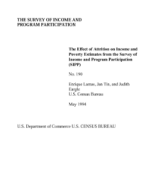
An official website of the United States government
Here’s how you know
Official websites use .gov
A .gov website belongs to an official government organization in the United States.
Secure .gov websites use HTTPS
A lock (
) or https:// means you’ve safely connected to the .gov website. Share sensitive information only on official, secure websites.
-
//
- Census.gov /
- Library /
- Census Working Papers /
- The Effect of Attrition on Income and Poverty Estimates from the SIPP
The Effect of Attrition on Income and Poverty Estimates from the Survey of Income and Program Participation (SIPP)
The Effect of Attrition on Income and Poverty Estimates from the Survey of Income and Program Participation (SIPP)
The Survey of Income and Program Participation (SIPP) provides federal policy makers and researchers with detailed income and poverty data on the Nation's households. SIPP is designed as a longitudinal survey where individuals are interviewed at relatively frequent intervals (every four months) for a period of two and two-thirds years. The longitudinal nature of the SIPP provides the opportunity to examine movements along the income distribution and factors associated with exits from poverty or with the duration of spells in poverty. For example, data on exits from poverty from the SIPP showed that, overall, 21 percent of persons below poverty in 1990 were not poor in 1991. However, the exit rate was higher (42 percent) for persons who worked year-round, full-time [U.S. Bureau of the Census (1993)]. The SIPP also provides the opportunity to examine the effects of changes in family composition on income and poverty estimates and supplementary data provide the ability to examine related issues such as asset spend-down of persons in poverty [Ruggles and Williams (1989)].
Others in Series
Working Paper
Working Paper
Working Paper
Share
Related Information
Some content on this site is available in several different electronic formats. Some of the files may require a plug-in or additional software to view.
 Yes
Yes
 No
NoComments or suggestions?


Top

